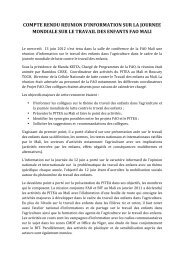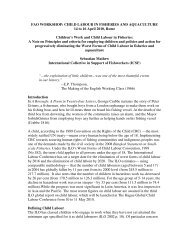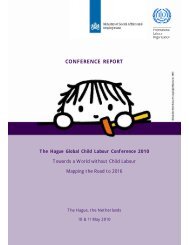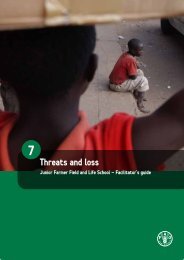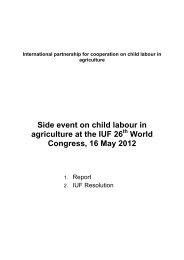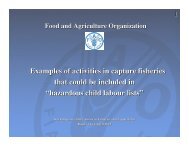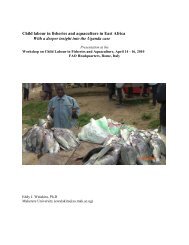Mainstreaming responses to the girl child in agriculture - Food ...
Mainstreaming responses to the girl child in agriculture - Food ...
Mainstreaming responses to the girl child in agriculture - Food ...
Create successful ePaper yourself
Turn your PDF publications into a flip-book with our unique Google optimized e-Paper software.
3.5 Research and sex disaggregated data on <strong>the</strong> extent of <strong>the</strong> <strong>child</strong> labour <strong>in</strong><br />
<strong>agriculture</strong> problem<br />
Hav<strong>in</strong>g sex disaggregated empirical evidence of <strong>the</strong> extent of <strong>child</strong> labour <strong>in</strong> <strong>agriculture</strong>,<br />
its forms and regularity is helpful, but often not available. Statistics can be used <strong>to</strong><br />
illustrate or analyse if <strong>the</strong>re are negative or positive social and employment impacts of<br />
agrarian reform on <strong>child</strong> labour. However, methodological guidel<strong>in</strong>es may have <strong>to</strong> be<br />
adopted <strong>to</strong> allow a fresh look at <strong>the</strong> concepts and def<strong>in</strong>itions used <strong>in</strong> agricultural<br />
censuses <strong>in</strong> <strong>the</strong> light of <strong>in</strong>corporat<strong>in</strong>g gender issues. For example questions on unpaid<br />
work should always be <strong>in</strong>cluded <strong>in</strong> surveys; questions that pick up <strong>in</strong>formation on<br />
illegal types of work, or multiple tasks that <strong>girl</strong>s may be engaged <strong>in</strong>, must be<br />
emphasized <strong>in</strong> agricultural statistical reports.<br />
Even when sex-disaggregated data are systematically collected, this is not an end<br />
<strong>in</strong> itself. Analys<strong>in</strong>g sex-disaggregated data should go beyond <strong>the</strong> simple differences <strong>in</strong><br />
percentages by sex and <strong>in</strong>clude analyses of causes, consequences, patterns and different<br />
outcomes for boys and <strong>girl</strong>s. For example it may be important <strong>to</strong> predict who tends <strong>to</strong><br />
migrate from rural areas and why, and <strong>the</strong> consequences for those left beh<strong>in</strong>d <strong>in</strong> terms of<br />
labour.<br />
Data is important when presented along with <strong>the</strong> consequences for both national<br />
social and economic <strong>in</strong>terests, <strong>in</strong>clud<strong>in</strong>g perhaps impacts on export markets and <strong>the</strong><br />
benefits of <strong>in</strong>vest<strong>in</strong>g <strong>in</strong> <strong>girl</strong>s education. Cost/benefit analyses on <strong>the</strong> impact on <strong>child</strong><br />
labour <strong>in</strong> <strong>agriculture</strong> are thus particularly useful, especially where <strong>the</strong> longer-term<br />
negative effects of <strong>child</strong> labour on human capital development can be highlighted. In<br />
Central America, two economic studies of <strong>the</strong> costs and benefits of elim<strong>in</strong>at<strong>in</strong>g <strong>child</strong><br />
labour overall provided such useful <strong>in</strong>formation for those advocat<strong>in</strong>g aga<strong>in</strong>st <strong>child</strong><br />
labour (Sauma, 2005). Available data on <strong>the</strong> <strong>in</strong>volvement of boys and <strong>girl</strong>s <strong>in</strong> <strong>the</strong><br />
process<strong>in</strong>g or market<strong>in</strong>g of agricultural produce, or <strong>in</strong> agro-<strong>in</strong>dustries is useful also.<br />
Thus it is necessary <strong>to</strong> be able <strong>to</strong> succ<strong>in</strong>ctly and conv<strong>in</strong>c<strong>in</strong>gly present <strong>the</strong> realities of boy<br />
and <strong>girl</strong> <strong>child</strong> labour <strong>in</strong> <strong>agriculture</strong> and how it is l<strong>in</strong>ked <strong>to</strong> national <strong>in</strong>terests.<br />
4. Respond<strong>in</strong>g <strong>to</strong> <strong>child</strong> labour <strong>in</strong> <strong>agriculture</strong> <strong>in</strong> policies and plann<strong>in</strong>g<br />
4.1 The scale of <strong>child</strong> labour <strong>in</strong> <strong>agriculture</strong> merits a ma<strong>in</strong>stream response<br />
There is a strong awareness that prevention of rural <strong>child</strong> labour will be preferable and<br />
more efficient than post-hoc approaches <strong>to</strong> treat <strong>the</strong> symp<strong>to</strong>ms of rural <strong>child</strong> labour<br />
(ILO, 2006a:53).<br />
Compulsory and affordable schools <strong>in</strong> rural areas is key <strong>to</strong> address<strong>in</strong>g <strong>child</strong> labour<br />
<strong>in</strong> <strong>agriculture</strong>. Poverty reduction strategies along with educat<strong>in</strong>g <strong>child</strong>ren and families;<br />
provid<strong>in</strong>g support services; rais<strong>in</strong>g awareness on <strong>the</strong> hazards of agricultural work;<br />
legislat<strong>in</strong>g on and regulat<strong>in</strong>g <strong>child</strong> labour and are o<strong>the</strong>r strategies put forward <strong>to</strong> date <strong>to</strong><br />
address <strong>child</strong> labour. In most <strong>in</strong>stances, different targeted sensitisation messages must<br />
be put <strong>in</strong> place for rural <strong>girl</strong>s than boys, because of <strong>the</strong> significant impacts of family<br />
situations, tradition and gender roles <strong>in</strong> <strong>the</strong> likelihood of programme success.<br />
U. Murray, P. Hurst - Draft for discussion - 12





